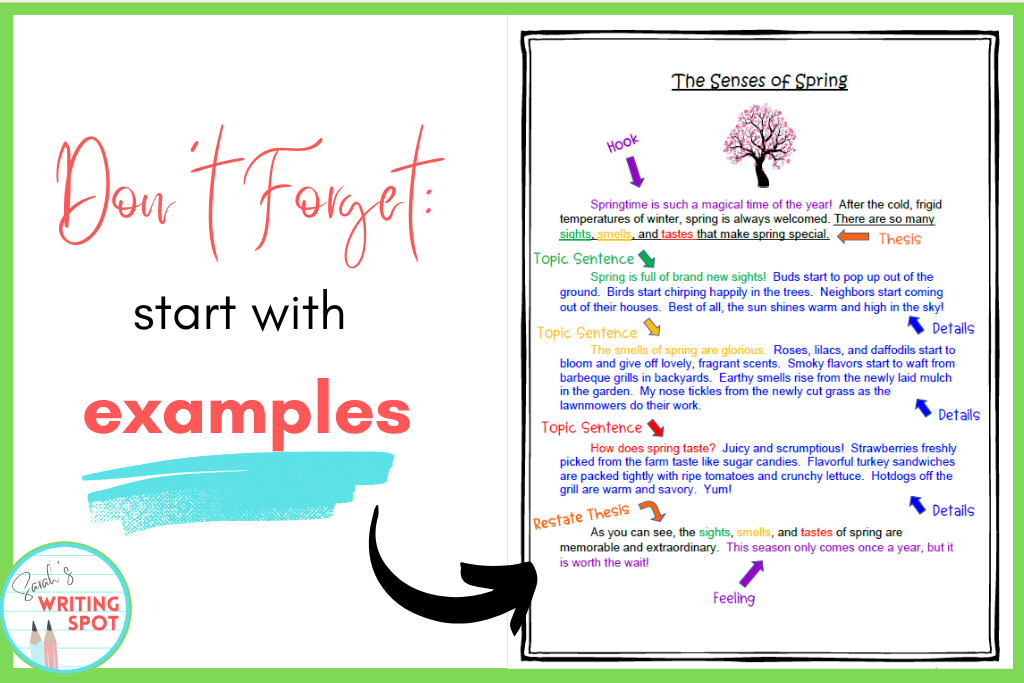Looking for some handy writing tips for essays? You’ve come to the right place!
Teaching how to write an essay can sure feel daunting sometimes. Am I right? Where do you start? How do you ensure your students will create their best work? Let me help ease some of that stress by offering a few tips to navigate those choppy waters.
Before we dive deep, though, how cool would it be if you could continue learning new writing tips even after reading this blog? You could get tips (and even lessons!) straight to your inbox that are only a quick click away. Sharing ideas is what makes good teachers great. You deserve any shortcut that will fast-forward you to greatness!
Is Writing an Essay Hard?
Tap, tap, tap. I could hear a pencil tapping the desk and looked up. The pencil stopped. I’d just written a prompt on the board and was expecting to see my students busily writing away. Yet…my students’ pencils were still. Or tapping. I could hear sighing. I could see wiggly bodies shifting in their chairs. And then I realized: my students have no idea where to start. Sigh.
And whose fault was that? Mine.
You see, my young teacher-self thought (naively) that I could simply write a prompt on the board and my students would….well…write. But, as seasoned teachers have learned, it doesn’t necessarily work that way.
So, back to the heading of this section. Is writing an essay hard? No! It doesn’t have to be! As long as you keep a few things in mind as you teach students how to write. (Things I wish I had known before I wrote that prompt on the board…)

Tip #1: Don’t forget to teach about pre-writing!
Whether it’s a bubble graph, list, chart, or organizer, teach students how to brainstorm first. Instill in them that some type of planning needs to take place BEFORE the rough draft. Otherwise, they’ll be heading down the road to Writer’s Block City.
Tip #2: Break essay writing into small pieces.
The idea of writing a 5-paragraph essay is overwhelming for students. Show them that it doesn’t have to be written all in one sitting. (Rome wasn’t built in a day!)
Model how to bite off small chunks by committing to one paragraph at a time:
Monday: Introduction
Tuesday: Body Paragraph 1
Wednesday: Body Paragraph 2
Thursday: Body Paragraph 3
Friday: Closing
Teach Your Students How to Write Essays Better
Have you ever been sitting on your couch grading papers and thought defeatedly, “Why are these papers so flat? So lifeless? ” Have you ever wondered how to bring out your students’ voices in their writing?
Give these tips a try to teach your students how to write essays better:
Tip #3: Use an example before you start a writing unit.
Always, always, always share an example of a writing piece before you ask students to write their own. Teaching persuasive writing? Share a persuasive piece. Teaching expository writing? Share an expository piece. Encourage students to analyze the example and identify how it’s different from other pieces they’ve written in the past.
Think about it: If you were told to change a flat tire and you’d never done it before, how well would your first try be? Now, imagine you watched a YouTube video on how to do it. Think you’d do better? Of course you would!

Tip #4: Write with your students.
Show students that you are in the trenches with them. Let them watch you struggle with your thoughts, rewrite your sentences, mess up, and try again. Explain that this is a GOOD thing. Not even the best writers in the world get it perfect the first time. Great writers always strive to make their writing more clear and interesting for their readers.
When you show students you aren’t afraid of failure, they will be more willing to take risks, too.
Tip #5: Embrace revising!
Most students hate this step in the Writing Process. They put so much effort into the rough draft and after that, they are D.O.N.E. “What? You mean I have to go BACK?” they ask.
To avoid making revising such a chore, why don’t you celebrate it instead? Invite students to share their before/after sentences that have been revised. Enthusiastically highlight the amazing transformation these changes made to their writing:
“Wow! I love how you added a hook at the beginning to draw in the reader! Doesn’t that sound so much better?!”
“It’s so awesome how you changed ‘walk’ to ‘ambled’ and then added ‘lazily.’ Bailey ambled lazily to her water bowl is so much more descriptive!”
Once others in the class see all the positive attention and feel-good vibes, they’ll want to make improvements, too!
Tips for Writing Narrative Essays
Let’s switch gears now to some tips for writing narrative essays. Full disclosure: I used to DREAD teaching narrative writing. Being Type A, I much preferred the convenient, organized layout of a 5-paragraph essay. This was my comfort zone. Introduction, 3 Body Paragraphs, Closing. Boom.
But, narrative writing? Not so much. The freestyling ways of storytelling gave me the willies. I even used to try to squeeze my students’ stories into a neat 5-paragraph format. Didn’t work. I just ended up sacrificing their voices.
What have I learned since?:
Tip #6: Frontload lessons on action, feelings, and dialogue.
Before jumping into a freewrite, dedicate a few days beforehand to teach these 3 essential components of narrative writing. Many students already use plenty of action. It’s feelings and dialogue that are often lacking. What can you do about that?
- Practice using correct dialogue punctuation
- Brainstorm other words than “said”
Practicing these tips will give your students more confidence when it IS time to freewrite.

Tip #7: Brainstorm narrative seeds with small moments.
Is a small moment really that important? Yes! Yes! Yes! Your 4th-5th graders are more mature writers now and they need to practice digging deeper into a small period of time. No more overly-generalized writing pieces about an entire week at the beach. I want to hear about the 5 seconds you got stung by a jellyfish– in detail!
- Model examples of what a small moment looks like and doesn’t look like
- Encourage students to write down examples of small moments in their own lives
Do those moments need to be extraordinary? Not necessarily. I’ve had students write interesting stories about missing the bus or losing a shoe!

Tip #8: Freewrite the rough draft.
When I teach 5-paragraph essay writing, I generally follow a formulaic pattern. For instance, we make sure the Introduction has a hook and a thesis. The Body Paragraphs have topic sentences and details with transition words. The Closing restates the thesis.
When I teach personal narrative writing, however, we just dive right in. By this time, I’ve already shared numerous narrative examples and we’ve practiced action, feelings, and dialogue. I tell my students to just write their story. Pretend they just sat down with their best friend and can’t wait to tell all about it. You could even have your students tell their story out loud to a classmate first to get the creative juices flowing.
Tip #9: Go back and zing it up!
Revising is one of my favorite steps of the Writing Process. (Can’t you tell? It’s the 2nd time I’ve mentioned it!) It’s a chance to take your writing piece from “meh” to “wowza!” It’s like a game for me. How many adjectives can I add? How many words can I change using the thesaurus? Can I find a place for a fun sound? Watching your piece transform can be magical! (Yes, magical!)
Empower your students with the tools of revising:
- Provide anchor charts with descriptive adjectives, adverbs, and sounds
- Explore the joys of using a thesaurus
- Use a revising checklist so students can improve their own papers
Your students’ papers should be beautifully messy and colorful by the time they’re finished!
Final Thoughts on Essay Writing Tips for Elementary Students
Now, you’re fully armed with practical essay writing tips for elementary students this year. You’ve got a few more tools in your toolbox. Whether you use just two tips…or all nine…you’re still making your way down that path towards better. Keep on groovin’ and makin’ those pencils rock. I’ll be here to cheer you on!
Write on, my Writing Friends!
SARAH

Looking for more regular advice to keep your writing plans sharp this year? Sign up for monthly freebies, tips, and discounts on new products!
Want your lesson plans written FOR you? Give these a try!
- 5 Paragraph Essay Examples
- Narrative Essay Examples
- 10 Essay Bundle: 5-Paragraph and Narrative Examples
- What is Figurative Language?
Related Articles on Writing Tips for Essays
4 Strategies for Teaching Students How to Revise
15 Topics for Persuasive Essay Writing
Writing and Editing Checklists for Elementary Schoolers
Who is Sarah from Sarah’s Writing Spot?




